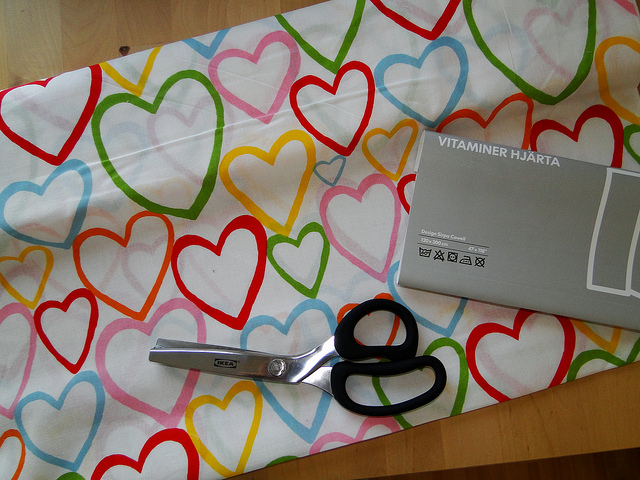Search Results: Video storytelling
10 Brand Storytelling Lessons In 2 Minutes
filed in Marketing, Storytelling, Strategy
 Take two minutes to watch this advert from IKEA. Those two minutes are guaranteed to change how you think about marketing your business. This video is more than just advertising designed to sell something—it’s a home run in brand storytelling.
Take two minutes to watch this advert from IKEA. Those two minutes are guaranteed to change how you think about marketing your business. This video is more than just advertising designed to sell something—it’s a home run in brand storytelling.
Ten things IKEA did to make their story great
1. Understood their customer’s worldview.
They have clearly asked and answered this question a thousand times.
“Why do/will people shop at IKEA?”
2. Made the customer the hero.
The product always plays the supporting role. Always.
3. Started with the customer’s story.
Most marketing tells the story of the product or service. It screams… “we need to shift more stuff”.
This story whispers….”look what you could become”.
4. Changed how the customer felt and acted in the presence of their product.
His belief about what’s possible for him changes. The same story resonates with a college student who is kitting out her first home with flat-pack furniture and expectant parents furnishing a nursery.
5. Understood what they are really selling.
It’s not chairs or bookcases.
6. Helped us to see reflections of ourselves in the hero.
His story is our story. We are all on a quest to be the better versions of ourselves.
7. Tapped into our emotions, creating a visceral connection with the brand.
There is not a fact in sight—no product name, price, store location. Nothing.
8. Created advertising that aligns with the company’s vision and brand personality.
Did the advert make you feel good?
9. Backed up the story with the experience delivered in-store and across all touchpoints with the brand.
Consistency is key.
10. Gave potential customers something to believe in.
Helping us not just to buy products, but to buy into the brand story.
It’s so much easier to adopt default thinking and lead by telling people what we do—which is why most businesses do it. But you are not most businesses.
Your customers are waiting for you to give them something to believe in and to take them where they want to go.
Image by Linda.
Lessons In Non-Profit Storytelling From The Best In The World
filed in Marketing, Storytelling, Strategy
 If you think times are tough in a marketing world where you’re actually providing goods or services in exchange for money, spare a thought for the marketers of charities who need to convince us to part with money without wrapping up something for us to take home.
If you think times are tough in a marketing world where you’re actually providing goods or services in exchange for money, spare a thought for the marketers of charities who need to convince us to part with money without wrapping up something for us to take home.
One of the biggest challenges non-profits face is justifying their operating costs. Supporters of charities have long questioned the amount of money spent on admin vs. how much actually creates impact for the worthy cause they donated to.
The Internet has made it easier for charities to reach people and to tell their story, but that access has also created a new breed of supporter who is both savvy and discerning. Access shouldn’t be confused with impact though. There are no shortcuts to mattering to people, but there are ways you can tell a better brand story.
7 Lessons In Non-Profit Marketing From charity: water
1. Declare a single enemy.
charity: water’s is dirty water. They explain how lack of access to clean drinking water impacts everything from health to time, poverty to education and the effect on the lives of women and children in particular.
2. The 100% giving model.
Build trust with transparency. charity: water stripped away all doubt about how much of the donated funds actually impacted good causes. They have two funding streams, donations to water projects from supporters and private donors and sponsors who fund operating costs. Donations are tracked to results in the field using photos and GPS so that supporters can see their impact.
3. Provide context
The size of the problem is still big (a billion people don’t have access to clean water), but charity: water breaks it down. They make the real impact of the donation more tangible.
My $20 buys access to clean water for one person.
4. Understand the donor’s worldview.
charity: water knows that we were buying the feeling that giving brings.
They worked out what supporters needed to know and how they wanted to feel and used great storytelling to make that happen.
5. Make it personal
The my charity: water platform gives people the opportunity to create their own campaign and a way to reach out to and connect with their supporters. This platform also makes it easy to both fundraisers and supporters to donate, keep track of progress and feel involved.
There are regular campaigns encouraging people to ‘donate’ their celebrations, like birthdays to the cause.
6. Leverage design.
Take a look at the charity: water website and you’ll see what I mean. Many charity websites feel clunky, they often have the feel of a dated corporate bureaucracy. This one feels like it’s alive, that it’s powered by community and intention, that work being done. The charity also has a recognisable symbol— the yellow jerry can.
7. Create community
charity: water makes it easy to share their story and your campaign via social media. They leverage all of the modern brand storytelling tools to both share the joy and create a sense of community.
Here is the charity: water Difference Map (created by me for the book Difference, not in consultation with charity: water). It might give you some clues about how to tell your own story.
Story Skills
filed in
introducing…
The Story Skills Workshop
What You’ll Learn
Storytelling Principles
Story Finding
Story Craft
Storytelling
Story Strategy

Make Your Stories Work for You
Story Skills Help You to Become A Better
- Storyteller
- Leader
- Salesperson
- Marketer
- Coach
- Presenter
- Speaker
- Teacher
- Activist
- Human
Are your ideas not getting the traction you hoped?
Are you looking for a way to reach and resonate with more of the right people?
If you have an idea you want to spread, better stories can make it happen.
We can spend years amassing expertise or creating game-changing ideas, products and services-yet, we don’t develop the skills to influence and inspire. I want to help you change that and teach you how to have the impact you want.
Stories are our most persuasive technology. We have scientific evidence to prove it.
According to Professor Paul Zak, ‘Narratives that cause us to pay attention and also involve us emotionally are the stories that move us to action.’ It’s our very makeup, our physiology, that causes us to respond to and be persuaded by stories.
Stories work because of this physiological connection between head and heart. Wherever you see a successful product, business or brand, look for the powerful story behind it. But these skills are not just for companies or professional storytellers.
Story skills are essential for anyone who wants to have a bigger impact.
Story skills are for activists and artists, entrepreneurs and educators, scholars and scientists. This workshop is for you if you want to make your ideas matter.
Do you want to become a better storyteller?
Sign up to receive updates about upcoming Story Skills Workshops.
Worldviews And The Story Of Bottled Water
filed in Marketing, Strategy, Worldview
 Do you remember the first time you saw bottled water for sale? For me it was back in the late 80’s when I was on holiday in Greece, where the tap water wasn’t safe to drink.
Do you remember the first time you saw bottled water for sale? For me it was back in the late 80’s when I was on holiday in Greece, where the tap water wasn’t safe to drink.
And then in the 90’s suddenly there it was. A trickle that turned into a deluge, supported by a worldview that we need to drink two litres of water a day and that bottled water is “better for you”. The global consumption rate quadrupled between 1990 and 2005.
Today the bottled water market is valued at $60 billion, and apparently the need to drink two litres of water a day is a myth.
Bottled water was not created to satisfy a need for thirsty consumers. It is a product designed to fulfil a western worldview about health. A 21st century creation that supports the story you can tell yourself about making the right choices. Like a take away Starbucks coffee cup, bottled water has become a statement as much as a product, for people with a particular worldview.
Bottled water companies didn’t create the worldview, they tapped into the beliefs at the edges of a market and created a product that supported those beliefs. More on that in this video (it’s well worth watching).
You should pay attention to the beliefs of the people you serve. Marketing and brand storytelling is about reminding people what they wanted in the first place.
Image by Dave Hoefler.
If Only You Could Write Like Malcolm Gladwell
filed in Entrepreneurship, Worldview
 WANTED
WANTED
“A professional writer talented in non-fiction storytelling with a passion for the topics of startups, social entrepreneurship, cutting-edge science and technology, and the psychology of the crowd, capable of crafting non-fiction pieces that are captivating and massively popular (think Freakonomics or The Tipping Point)
Location: Los Angeles or telecommute
To apply: provide your resume and relevant writing samples. Applications without writing samples will not be considered.
Responsibilities:
Work with a high-profile CEO of startups and foundations backed by some of the world’s most famous billionaires to draft blog posts and articles in his voice (i.e. all byines (typo not mine) will be that of the CEO).
Work with a small team of content researchers to identify topics and develop content.
Draft a series of blog posts based on the NY Times bestseller of the CEO.
Draft a series of original blog posts and articles based on interviews and research on subjects such as:
How to create audacious startups to change the world.
How to drive innovation through crowd-sourcing, open-sourcing, incentive competitions and DIY communities.
How billionaire entrepreneurs realized their audacious goals.
The position is a month-to-month contract (part time or full time), expected to last 8 to 14 months.
Required Skills:
Excellent writing and story-telling skills.
Demonstrated ability to create engaging non-fiction articles that entertain, intrigue, instruct and inspire by telling a good story with actionable lessons.
With a writing style/voice akin to non-fiction bestsellers such as Freakonomics and The Tipping Point.
Outstanding communication, interpersonal and interview skills.
An organized and creative researcher.
Able to work as part of a small 2-3 person team.
Content production, editing and publishing experience.
Familiar with online publishing platforms like WordPress.
Strong organizational skills and attention to detail.
Able to meet all deadlines.
Enthusiasm and passion for our subject matters.
A plus: audio and video production experience.”
This is a real position. The job is open. Yours for the taking.
But…if you can do even a fraction of what is “required” here, please don’t apply. Go build your platform. Tell your own story. Write bylines you care about. Build a team. Be audacious. Innovate. Then show others how to do that, on your terms, for as long as you like.
The difference you want to make doesn’t happen when you’re working week to week for a paycheck.
Don’t live in anyone’s shadow, not even Malcolm’s.
Image by Chris Christner.
20 Ways To Tell A Better Brand Story
filed in Storytelling, Strategy

Customers don’t buy your results, they buy the story about the difference those results will make. So have amazing ideas, make great things but remember to tell unforgettable true stories.
1. Name and claim a new category.
2. Clearly articulate what you do, without being boring.
3. Give people a great back story that explains why you exist on your about page, bio, profiles and in marketing materials.
4. Back up the story by doing great work.
5. Concentrate on speaking to customers with a particular worldview.
6. Paint a picture of the world as it is.
7. Then show your audience the world as it could be.
8. Uncover the essence of a problem and tell the story about how you solve that.
9. Appeal to all the senses. Stories aren’t just written, spoken or directed.
10. Use a variety of media to convey your message, show and tell.
11. Have a singular purpose and make yourself known for that. This doesn’t mean getting stuck in a box. Missions can work across products and industries.
12. Consider what one person says to another to recommend your ‘thing’. Make it easy to share.
13. Speak to your customer’s heart not just their head.
14. Optimise your website for visitors who you care to return, not just traffic that’s passing through.
15. Tell people how and why you are different.
16. Avoid using jargon. Simple language works, write as you would speak.
17. Don’t smooth away all the rough edges, be human and authentic. Honesty travels further than perfection.
18. Be consistent. Everyone in your company must understand your mission and the story you want to tell.
19. Give your customers the opportunity to tell the story and feel a part of it too.
20. Don’t try to be the ‘next blank’. A flawed original is better than a perfect imitation.
Brand storytelling in action
The Virgin Brand Story ~ We hate being ripped off by big expensive airlines and [insert industry here]. More people must feel like us, there must be a better way. Let’s be the better way.
Apple’s Brand Story ~ Technology can be beautiful as well as functional. Everything single interaction with our product must make people fall in love with it.
Chris Guillebeau’s Brand Story ~ Ever thought there must be more to life than this? Don’t want to work for the man? Me neither! This is how I do it, come join me to see how you can too.
The Epipheo Brand Story ~ We don’t create animated videos. We create epiphanies using great animation.
If you want to see a great brand story in action, check out Epipheo’s story in this video.
Image by rytc.
 It’s easy to think of great examples of B2C (business-to-consumer) brand storytelling. The list of B2C companies that leverage storytelling to engage with their customers’ grows daily. The perception in many B2B (business-to-business) companies is that it’s easier to engage with customers through story when you’re selling running shoes with a dose of ‘Just Do It’ motivation. Then there is the concern in B2B about justifying the resources and measuring the return on investment (ROI) in brand storytelling to stakeholders.
It’s easy to think of great examples of B2C (business-to-consumer) brand storytelling. The list of B2C companies that leverage storytelling to engage with their customers’ grows daily. The perception in many B2B (business-to-business) companies is that it’s easier to engage with customers through story when you’re selling running shoes with a dose of ‘Just Do It’ motivation. Then there is the concern in B2B about justifying the resources and measuring the return on investment (ROI) in brand storytelling to stakeholders.  So there we were gathered together on an island, (the best kind of place to feel that you’re truly gathered) to talk about the future of storytelling. Some of the best and brightest in the storytelling business from Burberry CEO (soon to be heading up the retail story at Apple),
So there we were gathered together on an island, (the best kind of place to feel that you’re truly gathered) to talk about the future of storytelling. Some of the best and brightest in the storytelling business from Burberry CEO (soon to be heading up the retail story at Apple),